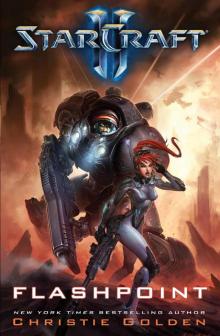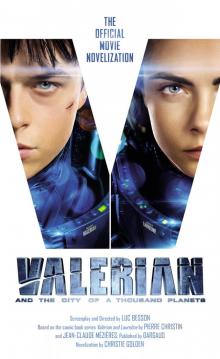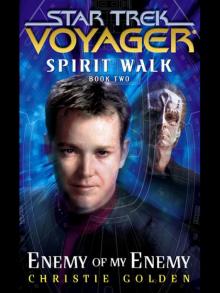- Home
- Christie Golden
Star Trek: Hard Crash (Star Trek: Starfleet Corps of Engineers Book 3) Page 3
Star Trek: Hard Crash (Star Trek: Starfleet Corps of Engineers Book 3) Read online
Page 3
For what seemed like an eternity, the ship shuddered under attack. Finally, it appeared that the worst was over. The power surged back on.
Lense turned her full attention to 110. The cortical stimulator was doing its job, and the spasming slowed, then stopped. A quick glance at her tricorder told her that the immediate danger had passed, though only a complete examination would reveal what, if any, permanent damage the Bynar had incurred.
She took a breath. She could use an extra pair of hands. “Computer, activate the EMH,” she ordered. At once, the slim, somewhat elegant figure of Emmett appeared.
“Good morning, Doctor—oh, dear,” said Emmett. “What happened?”
Lense noticed that his dark eyes had quickly taken in everything she had done before he asked his question. Good. She had never had so apt a pupil.
As he spoke, the door to sickbay hissed open. Lense turned her head quickly and saw that it was Sonya Gomez.
“Can you fill us in, Sonya?” she asked.
Gomez stepped closer, looking down at the Bynar with her arms folded tightly across her chest. “No one’s really sure,” she said. “He was attempting to interface with the computer aboard the alien ship when it appeared to send a massive shock throughout his system. He was caught in it for a few seconds, and then it shot him across the room. We had him beamed up the instant he was released.”
Lense extended a hand for Gomez’s tricorder, which had captured the whole event. She reviewed it in silence, Em peering over her shoulder.
“Who was working with him, or was he by himself?” asked Lense, handing the tricorder back to Gomez.
“Bart was with him at first, but he came over to look at the pilot’s remains after we noticed the—the holes.”
Lense glanced up sharply at the hesitation in the other woman’s voice. As a previous victim of burnout herself, she was always keenly alert to the manifestation of the symptoms in others. But Gomez appeared to be all right.
“Holes?” Lense demanded.
“Of course. You’ve been so busy keeping 110 stable, you haven’t had a chance to look at the body,” said Gomez. “There were holes in each of the arms. It was impaled on the chair.”
Lense glanced quickly over at the pilot’s body. Sure enough, there were three holes in the lower arms. Gomez was clearly a little rattled, and who wouldn’t be, upon discovering a body that had seemingly been impaled on sharp spikes in the command center of an alien vessel that had just gone on a city-wide rampage? Gomez wouldn’t be human if that hadn’t unnerved her at least a little.
“The pilot’s not going anywhere,” she said with a touch of black humor. “Right now, I’m more interested in 110. Did he do anything, touch any specific button? He had to have triggered something, or else the computer would have exploded the minute he tried to interface with it.”
“You’d think so,” said Gomez, moving hesitantly to stand beside the Bynar. “And he probably did, but no one was watching.”
“What about his own tricorder?”
“He hadn’t activated it. He never does.” She looked miserable. “Captain Gold’s reprimanded him about it before. It’s just not in the Bynar nature. Between their evolved brains and the buffer they carry with them at all times, they seem to have everything they need.”
“Perhaps when they’re on Bynar, but not when they’re all the way out here,” snapped Elizabeth. It could take days to translate the information stored on 110’s omnipresent buffer. But only the Bynars could figure out that gibberish. “If he’d recorded what happened in a way we could understand, we’d be a lot closer to knowing how to help him.”
“The pilot,” said Em slowly.
Lense and Gomez turned as one to look at him. “What about the pilot?” demanded Gomez.
Em seemed a little uncomfortable at suddenly being the center of attention. “Well,” he began, “according to your tricorder, Commander, the incident occurred as the pilot’s body was being transported out. We’ve seen that it was attached in some fashion—you used the word ‘impaled’—directly to the ship. Perhaps there were sensors that were triggered when the body was removed from the chair. The ship has to be operating on automatic commands. Maybe the removal of the pilot activated it.”
“Very good, Emmett!” said Elizabeth. She was proud of the EMH’s deductive reasoning, but a little embarrassed that she hadn’t figured it out herself. A quick glance at Gomez confirmed that the other woman shared her discomfiture.
Lense turned back to the supine figure of the Bynar. “There are first-degree burns on his hands and face,” she said. Whatever had happened to him had been bad enough to burn right through his protective gear. “Em, can you take care of those for me, please?”
“Certainly, Doctor,” Em replied, and began to run the dermal regenerator over the injured flesh while Lense continued.
“There appears to be no permanent damage to the brain. If he’d been human, there might have been, but Bynar brains are set up to be able to handle bursts of computer-generated information. Their limbic system can take an awful lot, more than almost any other humanoid species could. Whatever the ship’s computer did to him seems to have caused no lasting damage. You may tell Captain Gold I expect a full recovery. One more piece of the puzzle.”
“Can you awaken him? The captain will have a lot of questions.”
Lense hesitated. “Let’s give him some time. I want him more stable before I force him into consciousness. While we’re waiting, I can begin the examination of the pilot.” She nodded her curly, dark head in the pilot’s direction. “She should have a great deal to tell me about her race, if not necessarily her ship.”
Gomez lingered, looking anxiously at the still Bynar. “Sonya,” said Lense gently, “I’ll let you know the minute we learn anything.”
Gomez nodded her head, knowing a cue when she heard one. “Thanks, Doctor.” She turned and exited, running smack into Duffy.
“Sorry!” Gomez said.
“No, it’s my fault. Wasn’t watching where I was going.”
Lense looked at the two of them. It wasn’t a secret they had once been involved. And, judging by their awkwardness around each other when they weren’t in the midst of a mission, they hadn’t figured out what to do about that past involvement.
Duffy was wincing and clutching his hand. “Oh, no, did I hurt you?” said Gomez.
“No, no,” Duffy protested through clenched teeth. “I was heading down here to get this fixed.”
“I’m sure I didn’t help it any,” said Gomez. “Sorry, Kieran.” She hastened out.
Lense smiled. “Let me take care of that for you.” The injury wasn’t serious, just a bad sprain. When she was done, Duffy flexed his hand and gave her a grateful look.
“Thanks, Doctor. See you, Emmett.”
“See you, Lieutenant Commander Duffy,” said Emmett with perfect correctness, if too much formality. Lense would have to work on that with him.
Lense turned back to the task at hand. Her gaze traveled up and down the small, slight frame on the bed. Space had not done its usual fine job of preserving the body in this case. According to what the away team had reported, the ship had continued to maintain atmosphere, and the body had decayed normally. At the moment, it was safely encased by a forcefield; Starfleet SOP for the da Vinci in bringing any nonliving organic matter aboard.
Lense glanced at the readings. Nothing dangerous detected. She could safely eliminate the forcefield, but she would keep the body in stasis. Otherwise, the smell would be unbearable, and she wanted to prevent the body from decaying any further. She touched a button, then stepped beside the body.
A thought occurred to her. “Emmett,” she said, “have you ever performed an autopsy?”
“I am perfectly capable of performing an autopsy.” He looked offended. “It’s a standard part of my programming.”
She held up a placating hand. “Of course, you know how to do one, but have you ever actually done so? On an alien, about whom we know not
hing?”
He looked a little excited. “No, I haven’t.”
“You’ll find this fascinating,” she assured him. “I’ve been doing some comparative research on how this used to be performed in the old days, and how it’s done in other cultures. A few hundred years ago, they had no holographic technology. If you wanted to find out how someone had died, you had to literally cut them open.”
The sensitive hologram stared, mouth slightly open. “That’s … barbaric,” he stammered.
“Well, naturally, we think so, but that’s only because we have other methods to gain information,” she replied. “And there’s something about actually seeing inside a body, touching it, weighing the organs. It makes you respect death a little more, I think.”
“I prefer to respect life,” Em replied primly.
“Of course you respect life. Every doctor does. But on this mission, you and I are dealing mainly with the dead. You’ll need to cultivate respect for them, too.”
Em’s face furrowed. “But, Doctor, surely dealing with a holographic representation shows more respect to the body than cutting it open.”
“Yes—after a fashion. But let’s begin. You’ll see what I mean eventually.”
Despite everything that had happened, Lense couldn’t help laughing at the expression on Emmett’s dark face. “Don’t worry. We won’t be dissecting the body, I promise!”
Em looked very relieved. Still chuckling, Lense gave instructions to the computer. “Computer, prepare to construct an accurate holographic replication of the body on the biobed. All weights and textures must be exact.”
The biobed closed over the body and a lavender beam washed through the form.
“Prepared and awaiting data,” replied the computer in its cool female voice.
“Project the alien’s skeletal structure,” Lense ordered. “Keep it in the same position as it would normally be if held in place by tissue.”
Immediately, the skeleton appeared on the empty bed. It could easily have been mistaken for that of a human, save for the narrower jaw, extreme indentations of the skull at the temple point, longer finger bones, and a rib cage that extended almost to the hip.
“What conclusions do you draw from this?” she asked Em. He carefully examined the skeleton, leaning in to peer at it, his hands clasped behind his back.
“No, no,” said Lense. “A good doctor uses more than just his eyes. Touch it.”
Em was hesitant. “We are not programmed—”
“You’ll need to learn to exceed your programming here, Emmett. Go ahead. Touch it. Like this. Computer, adjust image to permit removal of individual bones without disturbing the construction.” Lense stepped forward and picked up the skull. She ran her fingers over it, feeling the smooth, slightly oily texture.
“This is unusual,” she said, caressing the indentations in the skull. She handed it to Emmett. “What do you make of it?”
“Perfectly circular,” he said, emulating her and running his fingers around the holographic skull. “It’s unlikely that this is a natural development.”
“Part of the torture that we think may have been performed?” It was a leading question, but she wanted to push him.
“No,” he replied with certainty. “The indentations are too old, too well-integrated into the skull structure to have been inflicted upon an adult. These modifications were begun when the patient—” His face fell a little, realizing that there was no “patient” to treat, only a body to examine. “When the, ah, subject was in infancy and the skull was more malleable.”
“Good,” approved Lense. “What else?”
Em was starting to get as excited as she was about this old-fashioned method of examination. “There are similar stresses in the radius and ulna. They’ve been manipulated over a long time to draw away from one another. Again, I would say this was begun in infancy. Perhaps for decorative or ritualistic purposes.”
“Good. And the rib cage? What does that indicate?”
“The extended rib cage indicates the strong likelihood of a multiorgan cardiovascular system, and perhaps other extra organs humans do not possess. And the lengthy fingers indicate that this race is probably quite dexterous.”
“You catch on quickly,” said Lense. “Computer, add internal organs, except for the brain.”
Blue light traveled down the skeleton, leaving in its wake an intriguing jumble of soft tissue. Lense nodded to herself. Emmett’s theory of two hearts had been dead-on. There were a few extra organs that they did not recognize. She went through them one by one, removing them and handing them to Em for his comments. The functions of most of them were immediately recognizable, despite the unusual shapes, textures, and colors. All humanoids had hearts, lungs, and organs that performed the functions of kidneys and livers. They might have different shapes and colors, and be located in different parts of the body, but they were always there. She frowned when they examined the digestive system.
“It’s unusually atrophied for a humanoid of this size,” she said. “What could be the reason for that?”
Em frowned. “Perhaps this alien has evolved to the point where it does not require fibrous foodstuffs in order to obtain its nutrients.”
It was a fascinating development, and one Lense had never before encountered, but it had no direct bearing on their real purpose. They could save that for later. Time to look at the brain.
“Computer,” she instructed, “replicate the alien’s brain.”
It appeared on the table, beside the skull. Lense was shocked. It looked, on first examination, no more complex than that of an average human. She had begun to wonder if this species was more highly developed, but apparently not.
Em, too, seemed a little disappointed. “It looks a great deal like a simple human brain,” he said.
“Let’s look a little closer. Computer, separate the brain along the two hemispheres.” The computer complied, and Lense picked up one in each hand, scrutinizing them carefully. “The corpus callosum is severely degraded,” she said, confused. That slab of white nerve fibers was what transferred important information from one hemisphere to another. Thus degraded, it made it highly unlikely that the pilot could function.
“It doesn’t look damaged,” said Em. “Perhaps the brain transferred information by some other method.”
Lense nodded, though she had her doubts. There were a few things common to all humanoids, and the corpus callosum was one of them. This body was becoming more intriguing to her by the minute.
Further examination of the brain only whetted her appetite. Other parts of the brain were degraded. Some seemed to be completely missing. Other areas were so developed as to be completely unrecognizable.
“This is absolutely fascinating. We’ll have to come back to this later, but I want to complete the procedure so that you’re familiar with it. Computer, add musculature.”
Again, the pilot’s muscles were not as well-developed as she would have expected. She glanced over at the actual body. It seemed fit and strong. Why, then, were the muscles so atrophied? This was not a result of decay, for the computer was programmed to extrapolate on how the musculature had been in life. She thought about the brain with its missing corpus callosum. Something strange was going on here. She asked Emmett what he thought.
“The muscles could be artificially stimulated,” he suggested.
She smiled a little. She’d caught him in an error. “But then the muscles themselves would show us that stimulation, wouldn’t they?”
He nodded, confused. “Then I have no theory,” he said, apologetically.
“Neither do I, not yet. Let’s see if the skin tells us anything. Computer, apply the epidermal layers.”
And this was when it always started to get to her. Once you had skin, you had a face, and once you had a face, you suddenly had a person. This face was a sweet one.
“It is a shame she died so young,” said Emmett softly. Lense shared his regret. The girl on the table, eyes closed softly as if in s
leep, was only an adolescent. In human years, Lense put her age at about fifteen. Just a girl, a child. She must have been attractive in life. Large eyes, with greenish freckles on skin that was almost human-colored, but a bit chalkier. Long brown hair with green highlights pooled around her head.
But there was something not right. Something was missing.
“Wait just a minute,” said Lense. She glanced back from the actual body to the holographic replication. “Look at the temples.”
Emmett followed her gaze. “They’re not sunken on the actual body,” he said.
“Exactly. Why do you suppose that is?” Without waiting for an answer, she went to the body and gently touched the temples. Her questing fingers found something hard and spherical.
Lense’s heart began to race. Firmly, she told herself not to jump to conclusions. “Something has been embedded here,” she said. “The computer didn’t replicate it because we didn’t ask it to. The good old sense of touch comes through again. Computer, scan the body. What is the source of the spherical nodes on the cranium?”
“Cybernetic implants,” replied the computer, utterly unperturbed by the direness of the words.
Lense swallowed. “Purpose?”
“Unknown.”
“Display on holographic replica. Remove skin layer.”
She caught her breath as the computer complied. The pilot lay before them, devoid of the skin that softened the emotional impact. Two silver spheres were nestled in the carefully cultivated nodules in its skull. The eyes, while organic, had also been augmented with implants. A thin silver wire ran like a shiny nerve along the pilot’s body. This, then, was the reason the muscles had atrophied. Artificial constructs had assisted them in doing their job. The missing corpus callosum was present and accounted for. It—and other parts of the brain—was utterly artificial.
She could see now the three cones that had been inserted between the bones of the lower arms. That was why the radius and ulna had separated so much; these metal cones had been implanted, and had forced them to grow apart.

 Rise of the Horde
Rise of the Horde World of Warcraft: War Crimes
World of Warcraft: War Crimes Fable: Edge of the World
Fable: Edge of the World Homecoming
Homecoming StarCraft II: Devil's Due
StarCraft II: Devil's Due Starcraft II: Flashpoint
Starcraft II: Flashpoint Allies
Allies Shadow Hunters
Shadow Hunters The Shattering: Prelude to Cataclysm wowct-1
The Shattering: Prelude to Cataclysm wowct-1 STAR TREK: VOY - Homecoming, Book Two - The Farther Shore
STAR TREK: VOY - Homecoming, Book Two - The Farther Shore King's Man and Thief
King's Man and Thief In Stone's Clasp
In Stone's Clasp Jaina Proudmoore: Tides of War
Jaina Proudmoore: Tides of War Vampire of the Mists
Vampire of the Mists Star Wars: Fate of the Jedi II: Omen
Star Wars: Fate of the Jedi II: Omen King's man and thief cov-2
King's man and thief cov-2 Star Trek
Star Trek StarCraft: Dark Templar: Twilight
StarCraft: Dark Templar: Twilight Lord Of The Clans
Lord Of The Clans ARKTIKA.1 (Short Story)
ARKTIKA.1 (Short Story) Before the Storm
Before the Storm STAR TREK: VOY - Homecoming, Book One
STAR TREK: VOY - Homecoming, Book One Shadow of Heaven
Shadow of Heaven Before the Storm (World of Warcraft)
Before the Storm (World of Warcraft) Warcraft Official Movie Novelization
Warcraft Official Movie Novelization Flashpoint
Flashpoint STAR TREK: The Original Series - The Last Roundup
STAR TREK: The Original Series - The Last Roundup On Fire’s Wings
On Fire’s Wings Spirit Walk, Book One
Spirit Walk, Book One Thrall Twilight of the Aspects
Thrall Twilight of the Aspects Valerian and the City of a Thousand Planets
Valerian and the City of a Thousand Planets Warcraft
Warcraft Assassin's Creed: Heresy
Assassin's Creed: Heresy Dance of the Dead
Dance of the Dead Arthas: Rise of the Lich King wow-6
Arthas: Rise of the Lich King wow-6 Assassin's Creed: The Official Movie Novelization
Assassin's Creed: The Official Movie Novelization Rise of the Horde wow-2
Rise of the Horde wow-2 Dark Disciple
Dark Disciple Ghost Dance
Ghost Dance The Shattering
The Shattering Spirit Walk, Book Two
Spirit Walk, Book Two Star Wars: Fate of the Jedi: Ascension
Star Wars: Fate of the Jedi: Ascension Star Wars: Fate of the Jedi V: Allies
Star Wars: Fate of the Jedi V: Allies The Enemy Within
The Enemy Within Kindred Spirits
Kindred Spirits The Farther Shore
The Farther Shore Star Trek: Hard Crash (Star Trek: Starfleet Corps of Engineers Book 3)
Star Trek: Hard Crash (Star Trek: Starfleet Corps of Engineers Book 3) Twilight
Twilight